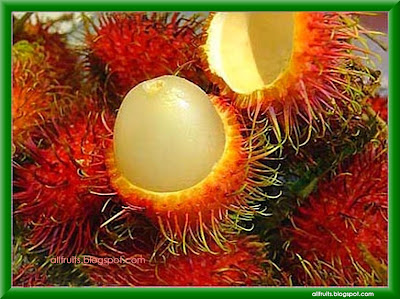Rambutan Fruit
Rambutan [The “Hairy” Fruit]
Scientific Name: Nephelium lappaceum (Sapindaceae).
Origin: A native of Malaysia and Indonesia
Other names: Ramboutan, ramboutanier, ramboetan, ramboostan, shao tzu, chom chom, vai thieu, ser mon, chle sao mao.
Distribution: Indonesia , Thailand , Malaysia , Vietnam , India , Burma , SriLanka, Central America , Philippines , Hawaii , Madagascar , Africa, Cambodia and Caribbean islands also produce rambutan.
This fruit colour may also be orange, red or yellow
There are other local names in the various dialects of Southeast Asia and the East Indies . Rambutan is commonly marketed all over Malaysia , Indonesia
The rambutan is a medium sized tree producing a red, orange or yellow fruit round to oval in shape. Its thin, leathery rind is covered with tubercles from each of which extends a soft, fleshy, red, pinkish, or yellow spine The fruit is oval-shaped and approximately 1 - 2 inches long. It is an evergreen tree growing to a height of 5–10 m (grafted tree).
Rambutan fruit is a tropical fruit that is known as one of the best fruit from Southeast Asian that has a delicious taste and benefits of good health to the body. Rambutan fruit inIndonesia , Philippines
The term rambutan is derived from the Malay word “hair”, which describes the numerous, characterizing, long, soft, red or red and green colored spine-like protuberances on the surface of the peel. The pericarp of this attractive oval-shaped fruit can be red, orange, or yellow in color and is removable by a twist of the hands. The edible, pearlish white, juicy, crispy, sweet and sub-acid flavored flesh conceals a single seed with a thin, fibrous seed coat.
The rambutan is not a well-known fruit, but it has great potential for its establishment and development because of the good agro-ecological conditions for its production.
The rambutan skin, which may be yellow, orange or red when ripe, is covered with many curved or fleshy whiskers, giving the fruit a hairy appearance. The fruit is usually oval to round and are borne on bunches. The skin separates easily from the flesh. Rambutan flesh is firm, white and translucent and is sweet and juicy. Preferred varieties have flesh that does not stick to the skin of the seed.
















